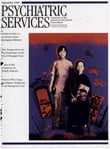Physical disorders among Southeast Asian refugee outpatients with psychiatric disorders
Abstract
OBJECTIVE: The study assessed the prevalence and duration of axis III physical disorders and the resulting level of disability among Southeast Asian refugee outpatients with axis I psychiatric disorders. METHODS: A total of 266 consecutive patients who were evaluated in a psychiatric outpatient clinic were assessed for the presence of axis III conditions through questions about physical symptoms, a medical history and review of records, physical examination, and laboratory screening. The sample included 158 Hmong, 58 Laotian, 43 Vietnamese, and seven Cambodian patients. RESULTS: Fifty-five percent of the patients had one or more axis III disorders, most of which were chronic and were not associated with extreme disability. Neurological conditions were most common, and the sequelae of war-related trauma were prominent. No associations were found between the presence of axis III conditions and age, gender, marital status, or ethnic group. In 48 cases, the axis III condition may have caused or exacerbated the axis I condition. CONCLUSIONS: Routine medical history and a physical examination, including a neurological examination, are recommended for all psychiatric patients, including outpatients.
Access content
To read the fulltext, please use one of the options below to sign in or purchase access.- Personal login
- Institutional Login
- Sign in via OpenAthens
- Register for access
-
Please login/register if you wish to pair your device and check access availability.
Not a subscriber?
PsychiatryOnline subscription options offer access to the DSM-5 library, books, journals, CME, and patient resources. This all-in-one virtual library provides psychiatrists and mental health professionals with key resources for diagnosis, treatment, research, and professional development.
Need more help? PsychiatryOnline Customer Service may be reached by emailing [email protected] or by calling 800-368-5777 (in the U.S.) or 703-907-7322 (outside the U.S.).



